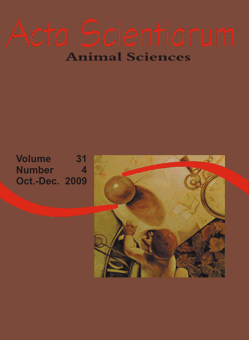<b>Performance of growing rabbits weaned at different ages, fed with two starch levels, from rabbit does subjected to different levels of energy on diet</b> - DOI: 10.4025/actascianimsci.v31i4.6622
Keywords:
feeding intake, feed, gain ratio, feeding cost, weigh gain, carcass quantitative evaluation
Abstract
240 litters of rabbits were used, from weaning to slaughter, in three parturition sequences, descended from rabbit does which were feed with different levels of digestible energy on diet and weaning age of young rabbits. The litters were allocated in a 2 x 2 x 2 x 3 factorial design (diets with 2600 and 2800 kcal DE kg-1 until weaning versus weaning at 28 and 35 days old versus diets with 21 or 16% of starch from weaning to slaughter versus three parturition sequences), with 10 replications (litters). The 2600 kcal DE kg-1 level improved weight gain, feed:gain ratio and reduced the diet cost from weaning to 50 days of age. Weaning at 28 days reduced the average feeding intake from weaning to slaughter. The higher level of starch reduced average feeding intake until 50 days of age and also reduced the cost. The parturition sequence increased the live weight at 70 days, daily weight gain and feeding intake during the experiment period, as well as heart, liver and kidney weight. The results suggest the use of feed with 2600 kcal DE kg-1, weaning at 28 days old and 21% of starch on diet for rabbits from weaning to slaughter.Downloads
Download data is not yet available.
Published
2009-11-19
How to Cite
Silva, W. R. da, Scapinello, C., Furlan, A. C., Moreira, I., Murakami, A. E., & Maria, B. G. de. (2009). <b>Performance of growing rabbits weaned at different ages, fed with two starch levels, from rabbit does subjected to different levels of energy on diet</b> - DOI: 10.4025/actascianimsci.v31i4.6622. Acta Scientiarum. Animal Sciences, 31(4), 365-371. https://doi.org/10.4025/actascianimsci.v31i4.6622
Issue
Section
Nonruminant Nutrition
DECLARATION OF ORIGINALITY AND COPYRIGHTS
- I Declare that current article is original and has not been submitted for publication, in part or in whole, to any other national or international journal.
The copyrights belong exclusively to the authors. Published content is licensed under Creative Commons Attribution 4.0 (CC BY 4.0) guidelines, which allows sharing (copy and distribution of the material in any medium or format) and adaptation (remix, transform, and build upon the material) for any purpose, even commercially, under the terms of attribution.
Read this link for further information on how to use CC BY 4.0 properly.
0.9
2019CiteScore
29th percentile
Powered by 








































